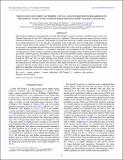The nucleus of Comet 10p/Tempel 2 in 2013 and consequences regarding its rotational state: early science from the Discovery Channel Telescope
Author(s)
Schleicher, David G.; Knight, Matthew M.; Levine, Stephen E.
DownloadSchleicher-2013-THE NUCLEUS OF COMET.pdf (294.3Kb)
PUBLISHER_POLICY
Publisher Policy
Article is made available in accordance with the publisher's policy and may be subject to US copyright law. Please refer to the publisher's site for terms of use.
Terms of use
Metadata
Show full item recordAbstract
We present new lightcurve measurements of Comet 10P/Tempel 2 carried out with Lowell Observatory's Discovery Channel Telescope in early 2013 when the comet was at aphelion. These data represent some of the first science obtained with this new 4.3 m facility. With Tempel 2 having been observed to exhibit a small but ongoing spin-down in its rotation period for over two decades, our primary goals at this time were two-fold. First, to determine its current rotation period and compare it to that measured shortly after its most recent perihelion passage in 2010, and second, to disentangle the spin-down from synodic effects due to the solar day and Earth's orbital motion and to determine the sense of rotation, i.e., prograde or retrograde. At our midpoint of 2013 February 24, the observed synodic period is 8.948 ± 0.001 hr, exactly matching the predicted prograde rotation solution based on 2010 results, and yields a sidereal period of the identical value due to the solar and Earth synodic components just canceling out during the interval of the 2013 observations. The retrograde solution is ruled out because the associated sidereal periods in 2010 and 2013 are quite different even though we know that extremely little outgassing, needed to produce torques, occurred in this interval. With a definitive sense of rotation, the specific amounts of spin-down to the sidereal period could be assessed. The nominal values imply that the rate of spin-down has decreased over time, consistent with the secular drop in water production since 1988. Our data also exhibited an unexpectedly small lightcurve amplitude which appears to be associated with viewing from a large, negative sub-Earth latitude, and a lightcurve shape deviating from a simple sinusoid implying a highly irregularly shaped nucleus.
Date issued
2013-10Department
Massachusetts Institute of Technology. Department of Earth, Atmospheric, and Planetary SciencesJournal
Astronomical Journal
Publisher
IOP Publishing
Citation
Schleicher, David G., Matthew M. Knight, and Stephen E. Levine. “The Nucleus of Comet 10p/Tempel 2 In 2013 and Consequences Regarding its Rotational State: Early Science from the Discovery Channel Telescope.” The Astronomical Journal 146, no. 5 (October 17, 2013): 137. © 2013 The American Astronomical Society
Version: Final published version
ISSN
0004-6256
1538-3881